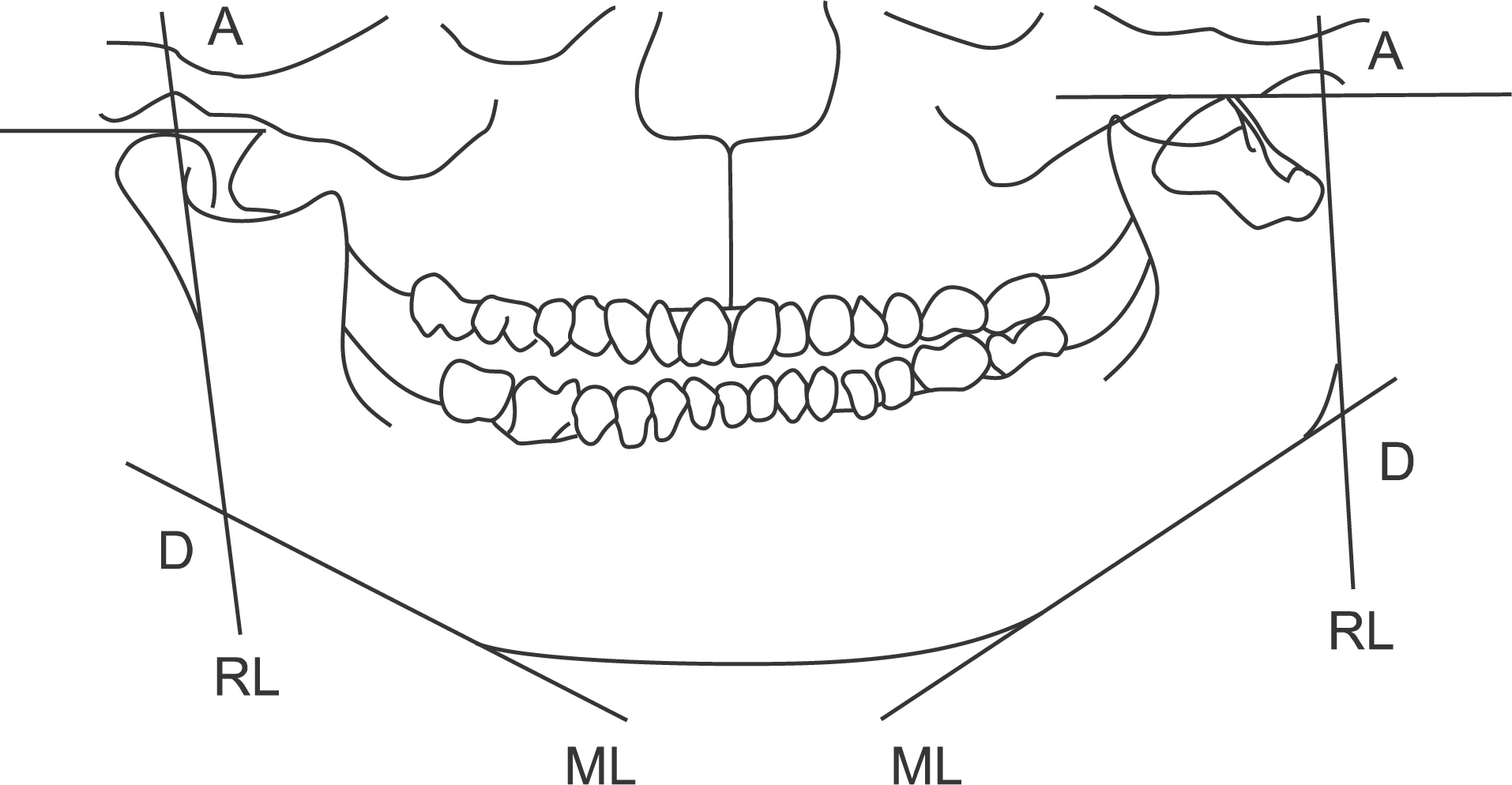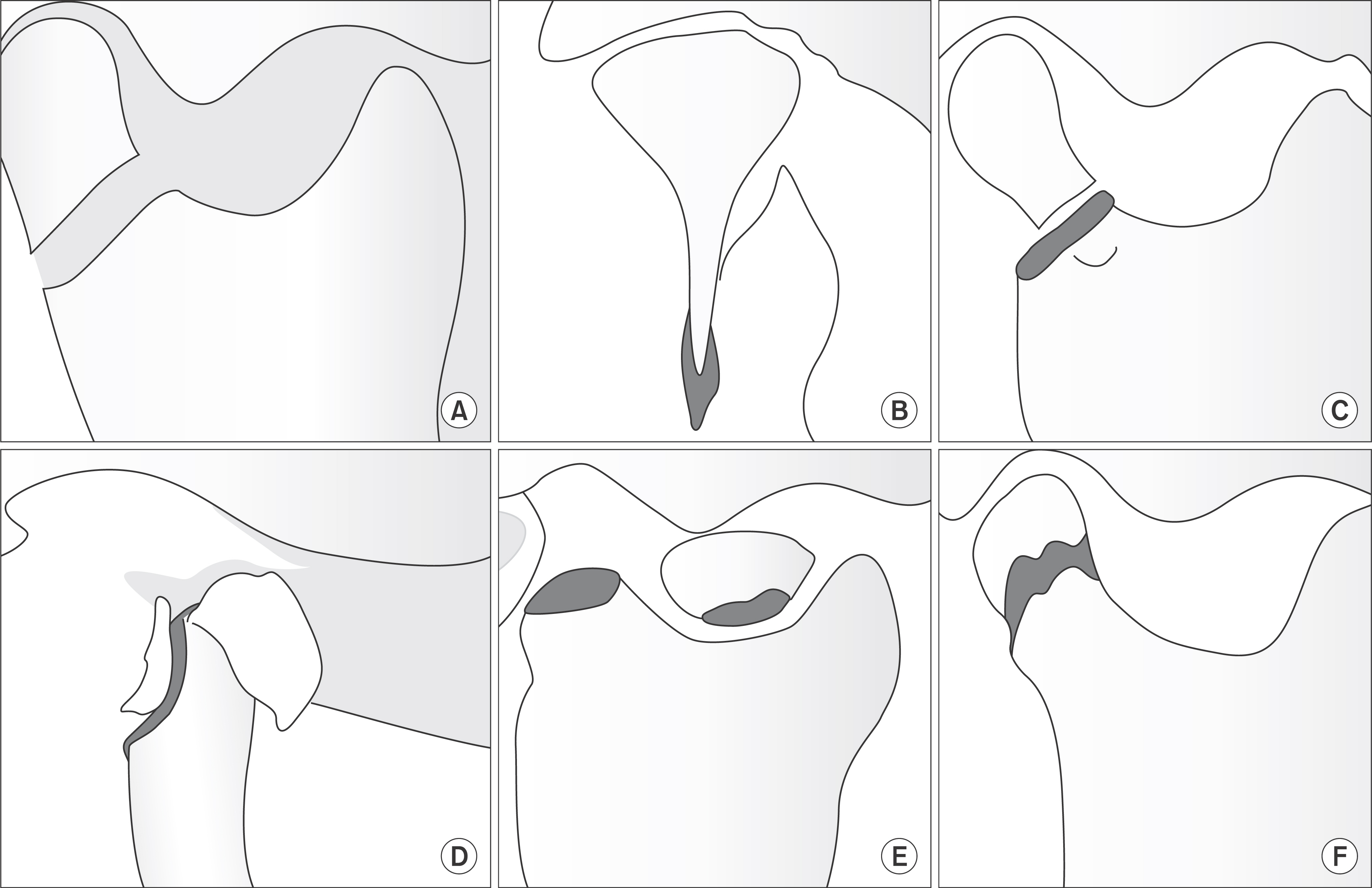J Korean Assoc Oral Maxillofac Surg.
2011 Dec;37(6):448-456. 10.5125/jkaoms.2011.37.6.448.
The study of the effect of mandibular growth and function in pediatric unilateral condyle fractures
- Affiliations
-
- 1Department of Oral and Maxillofacial Surgery, College of Dentistry, Dankook University, Choenan, Korea. lee201@dankook.ac.kr
- KMID: 2136980
- DOI: http://doi.org/10.5125/jkaoms.2011.37.6.448
Abstract
- INTRODUCTION
Condylar fractures are common in the maxillofacial region, comprising 29-40 percent of all mandibular fractures, accounting for about 20-62 percent). Previous studies reported that pediatric condylar fractures can cause disorders in facial growth and function, and the treatment methods have been controversial. Recently, conservative treatment has shown good results in skeletal growth and functional recovery but the conservative treatment of pediatric condylar fractures has shown unpredictable and undesirable results in some cases, such as facial asymmetry and temporomandibular joint disorder. This study examined the specific age groups and specific mandibular condylar fracture type in growing children treated conservatively in the past.
MATERIALS AND METHODS
Eighteen patients (10 men and 8 women) who received conservative treatment for unilateral condylar fractures in Dankook University Dental Hospital between 2000 to 2007 were followed up for a mean period of 7.2 years.
RESULTS
In the survey of 18 pediatric patients who received conservative treatment for condylar fractures, the incidence of temporomandibular dysfunction and growth disturbance was 45% and 35%, respectively.
CONCLUSION
In all complications, the symptoms observed most frequently was mouth opening displacement of the mandible exceeding 2 mm. The other complications of functional and growth disturbance included facial asymmetry concentrated along specific condylar types. Complications including facial asymmetry and functional and growth disturbances showed an increasing tendency according to the specific fracture types. Functional and growth disturbances in the undisplaced condylar fracture type showed a lower incidence(P<0.05). Functional and growth disturbances differed according to the fracture type, which has poor relationship with articular fossa and condyle(P<0.05). Functional and growth disturbance in the cases of the high-level condylar fracture type showed a higher incidence(P<0.05). The functional and growth disturbances of the fracture types were similar in the fragment-contact and non-contact groups(P>0.05).
Keyword
MeSH Terms
Figure
Cited by 1 articles
-
Open versus closed treatment for extracapsular fracture of the mandibular condyle
Junyeong Lee, Hee-Yeoung Jung, Jaeyoung Ryu, Seunggon Jung, Min-Suk Kook, Hong-Ju Park, Hee-Kyun Oh
J Korean Assoc Oral Maxillofac Surg. 2022;48(5):303-308. doi: 10.5125/jkaoms.2022.48.5.303.
Reference
-
References
1. Olson RA, Fonseca RJ, Zeitler DL, Osbon DB. Fractures of the mandible: a review of 580 cases. J Oral Maxillofac Surg. 1982; 40:23–8.
Article2. Buchbinder D. Treatment of fractures of the edentulous mandible, 1943 to 1993: a review of the literature. J Oral Maxillofac Surg. 1993; 51:1174–80.
Article3. Yamaoka M, Furusawa K, Iguchi K, Tanaka M, Okuda D. The assessment of fracture of the mandibular condyle by use of computerized tomography. Incidence of sagittal split fracture. Br J Oral Maxillofac Surg. 1994; 32:77–9.
Article4. Spiessl B. Rigid internal fixation of fractures of the lower jaw. Reconstr Surg Traumatol. 1972; 13:124–40.
Article5. Choi BH. Magnetic resonance imaging of the temporomandibular joint after functional treatment of bilateral condylar fractures in adults. Int J Oral Maxillofac Surg. 1997; 26:344–7.
Article6. Nørholt SE, Krishnan V, Sindet-Pedersen S, Jensen I. Pediatric condylar fractures: a longterm follow-up study of 55 patients. J Oral Maxillofac Surg. 1993; 51:1302–10.
Article7. Dahlström L, Kahnberg KE, Lindahl L. 15 years follow-up on condylar fractures. Int J Oral Maxillofac Surg. 1989; 18:18–23.
Article8. James RB, Fredrickson C, Kent JN. Prospective study of mandibular fractures. J Oral Surg. 1981; 39:275–81.9. Khosla M, Boren W. Mandibular fractures in children and their management. J Oral Surg. 1971; 29:116–21.10. Hovinga J, Boering G, Stegenga B. Long-term results of nonsurgical management of condylar fractures in children. Int J Oral Maxillofac Surg. 1999; 28:429–40.
Article11. Strobl H, Emshoff R, Röthler G. Conservative treatment of unilateral condylar fractures in children: a longterm clinical and radiologic follow-up of 55 patients. Int J Oral Maxillofac Surg. 1999; 28:95–8.
Article12. Cascone P, Sassano P, Spallaccia F, Rivaroli A, Di Paolo C. Condylar fractures during growth: follow-up of 16 patients. J Craniofac Surg. 1999; 10:87–92.13. Spiessl B, Schroll K. Gesichtsschadel, Bd. I-1. Nigst H, editor. ed:. Spezielle Frakturen-und Luxationslehre. 4th ed.Stuttgart: Thieme;1972.14. Allori AC, Chang CC, Fariña R, Grayson BH, Warren SM, McCarthy JG. Current concepts in pediatric TMJ disorders: part 1: etiology, epidemiology, and classification. Plast Reconstr Surg. 2010; 4:1263–75.15. Silvennoinen U, Iizuka T, Oikarinen K, Lindqvist C. Analysis of possible factors leading to problems after nonsurgical treatment of condylar fractures. J Oral Maxillofac Surg. 1994; 52:793–9.
Article16. Lund K. Mandibular growth and remodelling processes after condylar fracture. A longitudinal roentgencephalometric study. Acta Odontol Scand Suppl. 1974; 32:3–117.17. Pyo SW. Circummandibular wirng for pediatric mandibular fracture: case report. J Korean Assoc Oral Maxillofac Surg. 1995; 21:619–26.19. Adi M, Ogden GR, Chisholm DM. An analysis of mandibular fractures in Dundee, Scotland (1977 to 1985). Br J Oral Maxillofac Surg. 1990; 28:194–9.
Article20. Lehman JA Jr, Saddawi ND. Fractures of the mandible in children. J Trauma. 1976; 16:773–7.
Article21. Posnick JC, Wells M, Pron GE. Pediatric facial fractures: evolving patterns of treatment. J Oral Maxillofac Surg. 1993; 51:836–44.
Article22. MacLennan WD. Fractures of the mandible in children under the age of six years. Br J Plast Surg. 1956; 9:125–8.23. Gussack GS, Luterman A, Powell RW, Rodgers K, Ramenofsky ML. Pediatric maxillofacial trauma: unique features in diagnosis and treatment. Laryngoscope. 1987; 97:925–30.25. Thorén H, Iizuka T, Hallikainen D, Nurminen M, Lindqvist C. An epidemiological study of patterns of condylar fractures in children. Br J Oral Maxillofac Surg. 1997; 35:306–11.
Article26. Güven O, Keskin A. Remodelling following condylar fractures in children. J Craniomaxillofac Surg. 2001; 29:232–7.
Article27. McGuirt WF, Salisbury PL 3rd. Mandibular fractures. Their effect on growth and dentition. Arch Otolaryngol Head Neck Surg. 1987; 113:257–61.
Article28. Thompson HG, Farmer AW, Lindsay WK. Condylar neck fractures of the mandible in children. Plast Reconstr Surg. 1964; 34:452–63.29. Gilhuus-Moe O. Fractures of the mandibular condyle in the growth period. Histologic and autoradiographic observations in the contralateral, nontraumatized condyle. Acta Odontol Scand. 1971; 29:53–63.30. Dimitroulis G. Condylar injuries in growing patients. Aust Dent J. 1997; 42:367–71.
Article31. Lindahl L, Hollender L. Condylar fractures of the mandible. II. a radiographic study of remodeling processes in the temporomandibular joint. Int J Oral Surg. 1977; 6:153–65.32. Kahl B, Fischbach R, Gerlach KL. Temporomandibular joint morphology in children after treatment of condylar fractures with functional appliance therapy: a follow-up study us computed tomography. Dentomaxillofac Radiol. 1995; 24:37–45.
Article
- Full Text Links
- Actions
-
Cited
- CITED
-
- Close
- Share
- Similar articles
-
- Overview of Mandibular Condyle Fracture
- Retromandibular approach for open reduction & internal fixation of mandibular condylar neck fracture
- Relationship between mandible fractures and third molars
- Retrospective clinical study of mandible fractures
- The influence of the presence and impacted state of mandibular third molars on the incidence of mandibular condyle fracture




